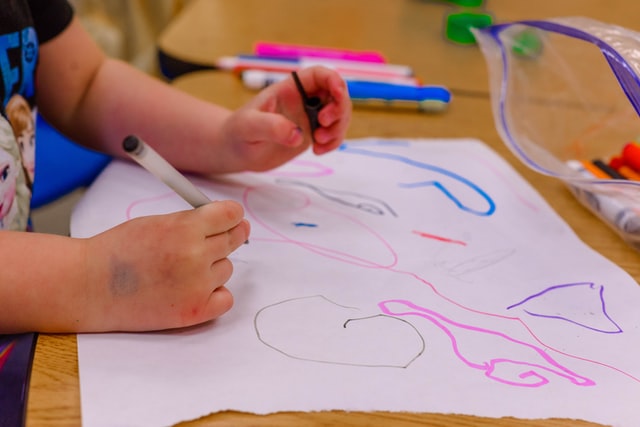 Photo by Erika Fletcher on Unsplash
Photo by Erika Fletcher on Unsplash
From scavenger hunts to obstacle courses to read-alouds, many activities from the classroom can be adapted for little kids learning from home.
One of the fundamental frustrations with the transition to online learning is the inevitable increase in screen time that results for students of all ages. For preschool teachers, this concern is compounded by the complexities of teaching 3- and 4-year-olds online. As one veteran preschool teacher I know put it, “The way I have been teaching for the last 20 years is out the window.”
At the Education Development Center, where I work to support young children’s STEM literacy, we are seeing successful virtual instruction strategies and practices emerging in the preschool teaching community, particularly among Head Start educators. Best practices range from the “take care of yourself” mantra that we all hear so much these days (and need to hear) to suggestions for onscreen read-alouds. Here are some ideas that we hope will be useful to early childhood educators.
11 TIPS FOR PRESCHOOL TEACHERS
1. Lean in with compassion: Be kind to yourself. No early childhood teacher has been trained to teach preschoolers online. “Online preschool” wasn’t listed as a pre-service course. However, early childhood teachers are expert at understanding young children’s behavior and creating developmentally appropriate learning environments—and you have more tools in your toolbox than you might think.
Remember to lean in with compassion for families as well. They’ve been in a state of constant, stressful adjustment, just like you, for many months now. Family routines are disrupted, and it may be difficult for parents to get their preschooler online when they have a baby crying, their first grader is asking for help during an online class, or they need to go to work themselves.
2. Adopt a growth mindset: Try different teaching approaches, and don’t be afraid of having a lesson flop; remember that every experiment provides more information that can inform the design of your next lesson. As one of the education managers we work with counseled her staff, “Don’t worry, you won’t harm the children.” It’s OK (and even advisable) to try new things during this time, and just like in a regular classroom, what might work with one group of children might not work with another.
3. Partner with families: You’re probably finding that you need to work much more closely with families to prepare for preschool than you’ve ever had to before. Using materials that are commonly found in children’s homes can ease the burden on both you and families. Consider asking parents to keep a preschool kit or box with materials you often use in your lessons, such as play dough, colored paper, markers, dice, or cards that children can bring to each session, or shapes that children and families could cut out together. This can make your work easier and help keep children’s learning spaces at home organized.
4. Remember that preschoolers’ attention spans are short: But they are even shorter when children have to be on a videoconference. As many people are learning, Zoom fatigue is real; it takes people more time, effort, and sustained attention to follow along during a videoconference. Preschoolers are no different. In fact, if a preschooler walks away from the screen, they are simply self-regulating—taking a brain break.
Often parents are with their preschoolers while online, which can make for a tricky situation for a teacher, particularly if a parent is upset that their child has walked away from your online class. Be sure to reiterate to parents that it is totally acceptable for their child to take a break as needed.
5. Keep activities short: When in person, children may be able to sit in circle time or whole group for up to 10 minutes, but that same circle time activity may not hold their attention when viewed in a conferencing platform such as Google Classroom or Zoom. Instead, try breaking up your lesson into small chunks with lots of movement embedded.
6. Get kids moving: Alternate between active and passive activities to help keep children engaged. Try a group movement activity such as creating a dance pattern, or have children do a quick scavenger hunt in their home (find three green things) and then regroup online to share and discuss what they found. By finding three things, children are also working on cardinality while moving around.
Another idea is to have children set up an obstacle course using pillows or toys, and then narrate their movement using prepositions that describe their positions and spatial relationships.
7. Set a routine and stick to it: Just like in the classroom, children benefit from knowing what to expect. Greet each child as they join the virtual room: Sing a song, dance along, read a book, have another movement or art activity, sing a closing song. If you can share a picture schedule on the screen or in their online classroom, or send home a printed picture schedule, this can support children’s understanding of what to expect during their virtual class.
8. Make your lesson do double (or triple) duty: Many preschool activities lend themselves to supporting the whole child and promote learning across domains, including language and literacy, math and science, executive function skills, logic and reasoning, and social and emotional skills. In practice, if you are exploring a theme such as seasons, you could use a book to launch your discussion and tie in science and math.
For example, Anno’s Counting Book takes the reader on a journey through the four seasons while encouraging number sense. The first page starts with zero—an empty winter landscape without anything to count. But as the book progresses from zero to one to two, there are more things to count and the seasons change too. If you’re teaching children online in the fall, they could collect leaves during breaks with their families and then count, compare, and sort them when they return to class. While sorting, children could describe their leaves’ attributes (Crunchy? Crinkly? Soft? Smooth? Brown? Green?).
Within an activity like this, children have a chance to build their number sense and vocabulary skills, explore science concepts, and share about the world around them.
9. Display books directly on the screen: In practice, we’ve noticed that preschoolers much prefer having the pictures from a book displayed directly on their screen rather than watching the teacher hold up a book and read aloud. It’s a bit like the difference between doing a large group book reading where all the children are clamoring to see the pictures versus reading a book with a child on your lap.
Using an e-book is a good way to achieve this, whether you borrow an e-book from your local library or use a site such as Open Library. Try keeping your camera on while reading so that children can still see your facial expressions as you read, or use Screencastify to record yourself and your book reading so that you can watch children’s reactions during the reading. You could also make a virtual book from children’s work using a platform like Book Creator, which can also be viewed easily onscreen and shared electronically with the entire class.
10. Experiment with creating games with standard online platforms: Similar to transforming a child’s screen into a book, use PowerPoint or Google Slides to turn their screen into a board game. For example, to continue the theme of seasons, you could create a simple sorting game that has a pile of leaves in two different colors, such as green and brown. On each side of the screen is a box filled in with the corresponding color. In real time you could move a leaf—for example, a green leaf—and put it in the brown box and ask, “Is this a match? No? I made a mistake—where should I put it?”
If children have limited language skills (or just want to have fun), they could hold up a piece of construction paper that is the same color as the sorting task to indicate where the leaf should be placed. This could be a good game to play one-on-one or in a small group. For math games specifically, consider pattern games or “how many are hiding” games.
11. Remember self-care: Teaching preschool virtually is very difficult, and as Covid-19 cases rise, so do our stress levels. Don’t forget to take care of yourself, give yourself brain breaks and movement breaks, make time for meaningful connections, or just get a little time alone.
Discover more tips for teaching preschool online with RobotLAB!

